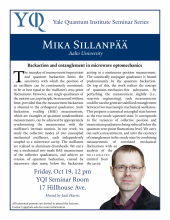Backaction and entanglement in microwave optomechanics
The interplay of measurement imprecision and quantum backaction limits the sensitivity with which the position of an oscillator can be continuously monitored, to be at best equal to the oscillator’s zero-point fluctuations. However, any single quadrature of the motion can, in principle, be measured without limit, provided that the measurement backaction is shunted to the orthogonal quadrature. Such backaction evading (BAE) measurements, which are examples of quantum nondemolition measurements, can be achieved by appropriately synchronizing the measurement with the oscillator’s intrinsic motion. In our work, we study the collective modes of two uncoupled mechanical oscillators, each independently coupled to a microwave cavity. The oscillators are realized as aluminum drumheads. We carry out a mechanical two-mode BAE measurement of the collective quadratures, and achieve an evasion of quantum backaction, caused by microwave shot noise, below the backaction arising in a continuous position measurement. The canonically conjugate quadrature is heated predominantly by the quantum backaction. On top of this, the work realizes the concept of quantum-mechanics-free subsystem. By perturbing the measurement slightly (i.e., reservoir engineering), such measurements could be used to generate stabilized entanglement between two macroscopic mechanical oscillators. This prepares a canonical entangled state known as the two-mode squeezed state. It corresponds to the variances of collective position and momentum quadratures being reduced below the quantum zero-point fluctuations level. We carry out such a measurement, and infer the existence of entanglement in the steady state by combining measurements of correlated mechanical fluctuations with an analysis of the microwaves emitted from the cavity.
